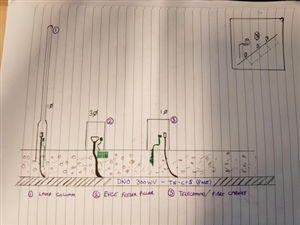I've been asked this time and time again and it could be a case that I've looked at this so much that it's made me go insane, but I'd like a 2nd opinion.
When installing a TT feeder pillar on the street, does the 2.5m rule come into effect when it's located near to a PME system or does this need to be 2.5m away from all other systems which are not connected to the same earthing system (not connected to the earth mat/rod under the feeder pillar?

SScho:
Hi Graham,
I understand you wouldn't want to bond 2 separate installations together if they were running off of different tappings or different transformers etc, but if you had two installations (both PME converted to TT) in the area, both run from the same DNO cable, both 3 phase (or containing the same phase as the other), then bonding the two installations together would be acceptable, no? As long as the conductors can carry the maximum fault current likely to flow through them, as this would fit the requirements of 542.1.3.3?
I understand a TT electrode being an adequate distance away from exposed conductive metals connected to a PEN conductor, but if the services nearby are also converted to a TT, then this need not apply. Is this correct?
If I'm not understanding this properly, please correct me, every day is a school day after all!


SScho:
Hi Graham,
I've done a quick drawing on a typical site to help explain what I'm proposing, and what would essentially happen is that you could install a link between all three METs, this would also increase the surface area of the copper earthing rods/mats and overall reducing the Ze. This would require the permissions of those who own/maintain the adjacent equipment to allow the earthing systems to be combined and also the installation of a label/notice, similar to the standard "Safety electrical connection, DO NOT REMOVE", maybe "This earthing system is interconnected with adjacent equipment - Do not remove", the furniture this is connected to could be confirmed by performing an R2 test with a wandering lead.
This would reduce the danger of having a potential between items and create a lower path of resistance to earth that the safety mechanisms of ADS and additional protection would be able to activate in an even shorter amount of time.
It seems like a very particular situation but in many streets and side roads, there is frequently only one supply cable which would make this possible, if the other installations weren't TT, then it may be possible to convert them to TT with the owners permission or to have them converted by the owner themselves. Wouldn't this remove the need for the required 2.5m between items? I admit, there are many "if"s involved, but we need to have a sensible method of being able to install the EVCE before it becomes impossible due to adjacent street furniture.
If I've overlooked something, please let me know and I can have a look at different ways around the issue.
gkenyon:
I still see some form of litigation nightmare happening here, unless you can clarify who owns what - and if separate duty holders, ensure there are covenants of similar in place???
Even if the supplied chargers and lamp-posts are operated by the same duty holder, the DNO may make changes to their arrangement at any time.
We're about to take you to the IET registration website. Don't worry though, you'll be sent straight back to the community after completing the registration.
Continue to the IET registration site